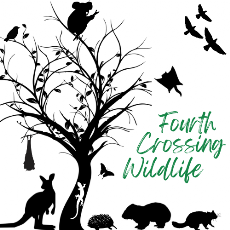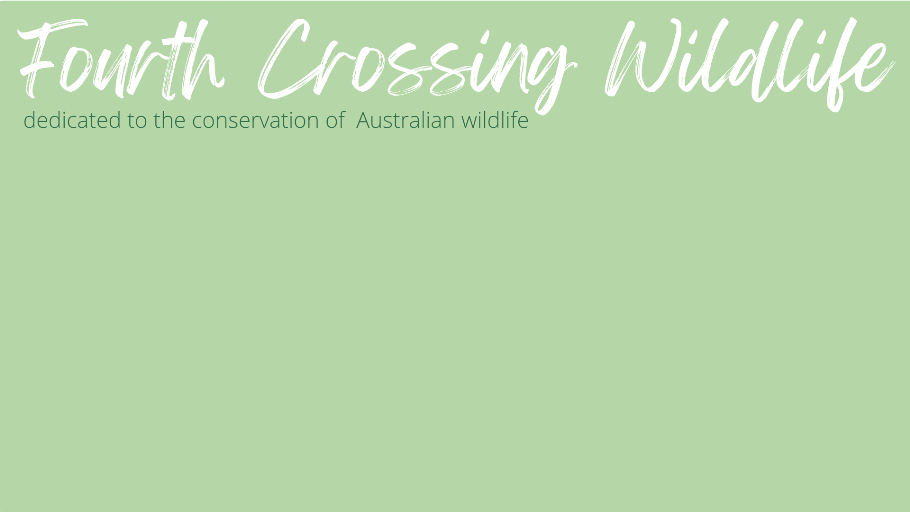Stories
Avian Pox - a Cruel Diesease
by Linda Dennis
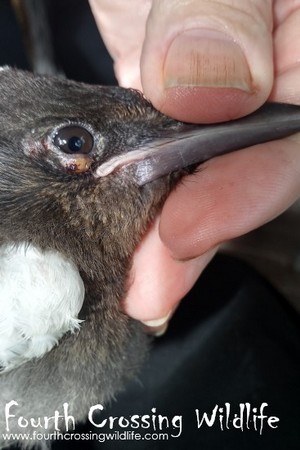 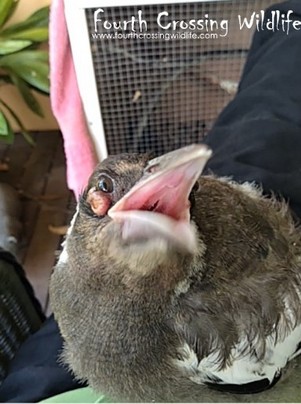 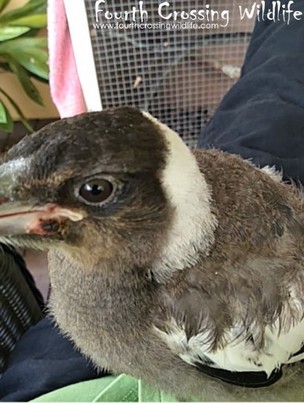 | This is the story of Fry the Australian Magpie and her battle with Avian Pox (avipoxvirus). We were driving home after a few days away when, not far from home, we saw a magpie lying flat on the road. We presumed it had been hit by a car. Todd make a quick halt and U turn then bolted out of the car to rescue the bird before another car squished it entirely. It was 35 degrees in the shade and really humid. The bird was on the hot tar, literally cooking in the sun. Her wings were splayed and her beak was gaping in an effort to cool down. We discovered she was a nestling, too young to fly, she had probably fallen out of a nearby tree. When Todd approached her she feebly tried to flap away but was way past proper movement. She was not a candidate for putting back in a nest which we gathered was high in the only pine tree near where she was located. She needed to be cooled and then well hydrated for any chance of survival. So, home she came with us. It was Todd - with his whacky sense of humour – who named her Fry. After cooling her down slowly in the air conditioned car, we started on oral rehydration with pre-boiled warm water mixed with sugar and salt. Luckily, she was easy to give water to and seemed to like the flavour of the water (sweet and mildly salty). Over several hours we gave her regular small amounts of water and when she was adequately rehydrated she readily took food (mince mixed with dog kibble, raw egg, calcium and multi-vitamins) although we could tell that she wasn’t particularly fond of the concoction we made up. She much preferred the insects and worms that Todd found for her. Fry was checked over for injuries and didn’t appear to have any. Wings and legs looked good with no apparent injury. Her keel bone was extremely prominent, however, and we wondered how long she had been on the ground and maybe not being fed. It wasn’t until four days later, when she started to get more active, that we realised she had an injured right leg. It didn’t appear to be broken, she had good movement of her toes and she perched well. She just hobbled a bit when she walked. On consultation with the vet we were advised to offer pain relief and monitor the leg well as there still may be a fracture from the fall out of the nest. Luckily, that turned out not to be the case and her leg improved over the week. Seven days later we noticed that Fry had a very small sore on her right eyelid, under the eye, and another on the left side of her beak. Both were slightly inflamed. We decided to give her a warm bath as she was pretty mucky from the nest (as nestlings can be) and we wondered if there was a mite aggravating her skin. We hadn’t washed her up to that point as we didn’t want to distress her or make her sore leg any worse. She tolerated the bath well, but was a bit grumpy afterwards. After a couple of days, and probably due to the Meloxicam for her injured leg, the inflammation on the two sores reduced. Two days later Fry was moved into the small outside enclosure that Todd made for her. She was still a nestling but she wanted to be perched on tree branches rather than sit in a makeshift nest. We placed some toys in the box for her – fun hanging, jingly ones! – and she loved playing in there and often chortled happily to herself. She was a happy bird. We decided to apply Betadine to the small sores on Fry’s face. They seemed to be aggravating her, they were itchy, and we didn’t want them to end up infected. We kept that up, twice a day, for a while but stopped when we thought the Betadine seemed to be making them more itchy. Approximately 10 days later, we noticed that there was another lump under Fry’s right wing and one forming behind her left eye. I spoke with a vet about the lesions and sent photos, asking if they were mites or avian pox and was told they were likely pox and advised to continue washing with diluted iodine (Betadine). I’ve had experience with two cases of pox – one in a chough that resulted in the bird not being able to fly, and the other in a kangaroo, just two “warts” on the arm and finger. The lesions on Fry looked quite different to both those cases so I wanted to liaise with a vet to make sure I was providing appropriate care for Fry. I also did a lot of research into the disease (below in yellow). |
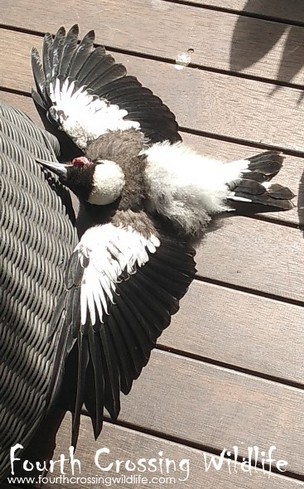 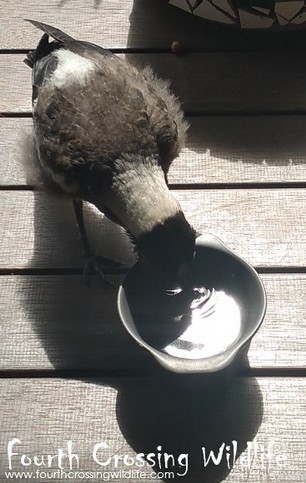 | RESEARCH Avian pox (avipoxvirus) – also knowns as AVP - is a virus. It is one of the oldest known infectious diseases of birds. It is transmitted through broken skin (it cannot penetrate intact skin) with the main vector being mosquitoes (mites, midges, fleas and flies). When there are higher numbers of vectors (eg, after rain) the virus transmission is more virulent. Transmission is also via consumption of or by breathing in infected particles. It is comparable to chickenpox and monkeypox in humans. It is a highly contagious disease (between birds) and has been detected in more than 230 species of bird world-wide, both domestic and wild. There are several different strains of avipoxvirus which have been classified by the original host, eg: canarypox virus, fowlpox virus, mynapox virus and penguinpox virus. However, these strains can infect any species of bird. It is not known to cause disease in humans (it’s not a zoonosis) as it cannot complete its replication cycle in non-bird species. The virus has been adapted to living in the dry mucous membranes of the host and in the upper respiratory tract. Unlike other viruses, it can withstand extreme dryness and as a result can spread on dust particles. It appears to withstand extreme cold conditions as an infected Southern Giant Petrel in Antarctica proved in 2008, although it is more prevalent in warmer climates. The virus’ impact on wild birds is as not well known as in poultry (domestic birds) but it is known to limit the survival of wild bird species. Lesions occur on the non-feathered parts of the bird including legs, under wings and on the face around eyes and beak. Effects of the disease can cause difficulty in breathing, eating and drinking. In a healthy individual, poxviruses present ordinary-type infections but those with compromised immune systems can display a severe form of the disease. There are two forms of avipoxvirus : dry pox and wet pox. Dry pox affects areas of skin (non-feathered) on the outside of the body and is characterised by wart-like lesions or tumours. Wet pox affects the mouth and respiratory system, including the lungs and is characterised by mucosal plaques. Wet pox is likely to be fatal (as the bird will be unable to eat, drink and breathe) but in many cases dry pox can be successfully treated, depending on the severity of the disease. The severity of the disease depends on many factors such as environmental, physical stress/distress, route of infection and the strain of the virus. If the individual survives the virus it then becomes immune to that strain. A vaccination has been formulated for some strains of APV (such as fowlpox virus) which can be given to domestic birds but is not feasible for wild free-ranging birds. There is no known cure for avipoxvirus. Prevention measures for birds-in-care include : limiting standing water that are good breeding grounds for mosquitoes, good hygiene and quarantine of infected birds. Supportive care can be given to infected birds. The disease is thought to run its course (self-limiting) with or without treatment. If the symptoms are mild then support care can be given, including pain relief. Allowing the bird to “sun” itself also provides relief to the lesions. Antibiotics might be needed for secondary infection. It's thought that Aciclovir may assist mild lesions - this is an antiviral topical cream or oral medication for cold sores on humans. |
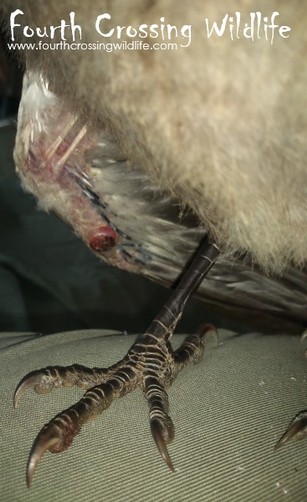 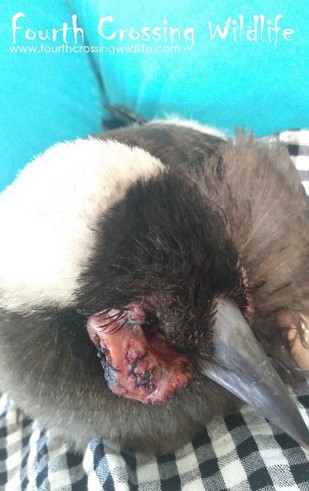 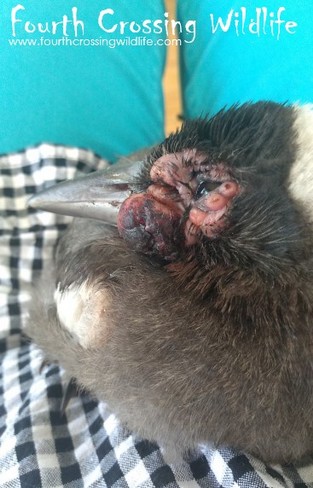 | Over the next few days the lesions grew at an alarming rate and became quite inflamed. The weight of lesion on Fry’s right eye started to drag the skin around the eye down which caused her some discomfort, which increased over days. Having stopped the Meloxicam for Fry’s injured leg, we were advised to start it again to help with the inflammation and any pain caused by the APV. We also gently bathed her head and wing in a salty solution. Fry’s pox was the “dry form” but, I now realise in hindsight, it was a severe form of the disease. She was still eating well, like a horse actually, and regularly drank water from a bowl so that told us there was no “wet form” present. We were advised to speak with a local vet about getting systemic antibiotics as a precaution. I contacted a local vet and was advised there was something better than antibiotics in this case – an antiviral medication called Aciclovir, a human medication that is used to kill the herpes virus (cold sores) around the mouth. I was told to treat 3 times a day. I rushed into town and bought a tube of the cream and started applying it the same day. Initially we thought we saw an improvement to the lesions, they looked less inflamed on the second day of application. Then the lesions seemed to dry out and blackened which we assumed was the virus dying. But our hopes were short lived. I had taken a photo of the pox lesions on the first day of treatment and then again on day five. Although the original lesions hadn’t increased in size, we saw that there were more growing around both eyes and on the beak. The vet advised to continue treatment until the lesions fell off (once the virus has died the lesions dry and fall off the body) and new ones stopped forming. Up until this time Fry had been such a happy magpie. She fed, drank, groomed, played and chortled. She had moments of what I call depression, where she obviously felt pretty miserable. But then she rallied and was back to her normal self – it was a bit of a roller coaster ride. The morning of her last day, Fry was in such high spirits. She was really joyful. It was such a pleasure to see her being so happy even though she was sick. She gave us hope she would pull through. Lunch time came and we had to clean the lesions and apply the Aciclovir again. But after that, Fry crashed – the change in her demeanour was astounding. She stopped making any noises, she stood in the one spot and her head slumped to her chest. Nothing perked her up. She wouldn’t eat or drink. When we approached her, she’d look at us and making her little cooing sound then laid her head on her chest and slept. We agonised over what to do. But we both knew that it was time. In this case, the Aciclovir had not worked. Fry’s condition was not one that could recover from the disease, we saw that now. She was only going to die in a prolonged, drawn out process. We simply couldn’t do that to her. We said our goodbyes and Fry crossed over The Rainbow Bridge. Devastated is not a strong enough word. Knowing that avipoxvirus can spread via dust particles, we burnt all her bedding and perches and disinfected the bird box. Fry was disinfected and was buried not far from our home. Back to the bush, but not in the way we had hoped. We often talk of the horribly cruel diseases of mammals such as the devastating impacts of Sarcoptic Mange in wombats and we call on our governments to provide assistance and funding to find a cure for the disease – but we don’t talk about or demand a-call-to-action on avipoxvirus which is as equally dire, equally as contagious and equally as cruel. (I think now of Fry’s siblings, if there were any, that would have died slowly and painfully). A cure must be found to stop our native and domestic birds from succumbing to this truly horrible condition. The moral of the story – this case has been a huge learning curve. If I ever had another bird that developed APV lesions that grew so rapidly, I would euthanase well before they took hold. Some birds with lesser dry pox strains can be successfully treated, but not those that develop so quickly. Love and Light, Fry. References : Wikipedia – avipoxvirus The Biology of Avipoxvirus in New Zealand Avifauna by Hye Jeong HA PennVet – University of Pennsylvania – Avian Pox |
